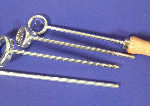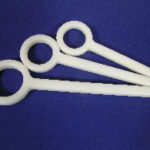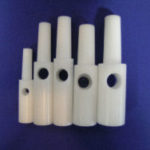By playing only on the mouthpiece, the instrument’s acoustic resonation is removed. There is much stimulus involved with the instrument. A player will pick it up, put his hand in position, and a signal is sent from the mind to the embouchure at the mouthpiece. At this point, the instrument resonates.
To introduce change, removing the instrument will force the student into recall and mentalization so that he can immediately concentrate on the musical factor. All of the tissues involved in playing are still involved with the exception of the hands holding and fingering the instrument. When returning to the instrument, the signal being sent to the embouchure is usually improved.
Another method of mouthpiece practice is using a mouthpiece rim [visualizer]. Jacobs does not recommend buzzing without a ring to isolate the embouchure’s vibrations that go from the center to the edges of the lip. There is the possibility of deterioration of the lip’s muscles without the use of a rim. He recommends that buzzing should only be done in the low and middle range for only two or three minutes at a time.
Video – Mouthpiece Buzzing


Many mistakenly call rims “embouchure visualizers,” but they have more uses than to observe the placement of one’s embouchure. The real value is to buzz their lips without the use of a rim. We have developed trombone (euphonium) and tuba rims made of delrin that cost less than those made of brass. To isolate the lip’s musculature, Jacobs cautioned students not buzz without a rim.
Video – Buzz Without Rim
Buzz Aids

The mouthpiece is placed in the Buzz Aid to add resistance while buzzing through it’s two holes. It can also be placed in the instrument’s receiver to simulate playing the instrument while buzzing. They are available for horn, trumpet, tenor or bass trombone and tuba.
